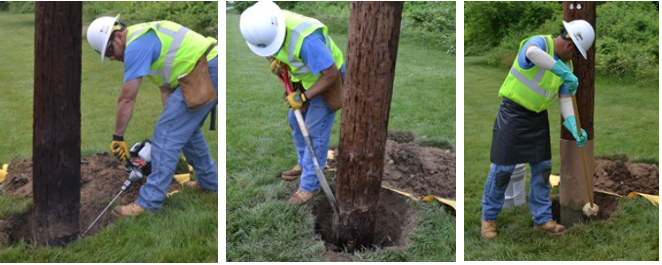

Use of higher-grade steel means steel reinforcement members can be lighter and more cost-effective than more common, lower yield material. Some manufacturers offer specially shaped trusses that use steel with yield strengths as high as 100,000 psi. These trusses, when properly sized and oriented, are engineered to restore the code-mandated strength to the weakened structure, without accounting for any wood strength in the weakened area that may remain. The highest bending loads a utility structure withstands are a result of weather events such as high wind or high wind and ice accumulation acting on the pole and all of its attachments.

When bending loads are applied to the structure, the resulting bending movement is transferred to the truss, which bypasses the decayed or damaged area of the pole and transfers it to sound foundation below ground. Trusses are driven to predefined depths and secured to the pole with high-strength steel banding. It is highly recommended that steel trusses be galvanized to reduce long-term corrosion potential. Truss systems are widely used by utilities and are the lowest available cost restoration option for poles with groundline decay. The most common and proven rehabilitation system that helps restore groundline strength to wood utility poles involves the installation of a single, or in some cases a double, steel member known as a truss. Structure owners should ensure sound engineering practices have been followed in the restoration system design and that the system has been thoroughly tested and proven over time. In addition, long-term performance and consistency should be a factor in selecting a restoration system. Every component of a structural rehabilitation system should be tested and documented by the vendor supplying the material. When specifying and implementing restoration systems, utilities are urged to select engineered products and companies that have a proven installation and safety track record. There are a number of vendors and contractors that offer various structure restoration systems. Depending on the severity, pole owners may be able to structurally rehabilitate these weakened assets at a fraction of the cost to replace them. Identifying problems such as groundline decay, corrosion, and damage is a key component of avoiding dangerous and costly pole failures. The goal of a routine and methodical inspection and life-extension program is to monitor and remediate utility structures to maintain or improve the structural health and safety of overhead lines. Utilities have become increasingly aware of the need to inspect their transmission and distribution poles on a cyclical basis. The use of restoration products provides utilities with significant economic advantages, as well as structural and environmental benefits. Strengthening solutions that add capacity to poles and towers to enhance structural resilience are also available in the marketplace.
#OSMOS POLE TESTING CODE#
Several proven products exist to rehabilitate utility structures that no longer meet the code requirements as a result of decay, corrosion, or mechanical damage. As transmission and distribution infrastructure worldwide continues to age, utilities must seek creative and cost-effective solutions to problems that naturally accompany aging assets.


 0 kommentar(er)
0 kommentar(er)
